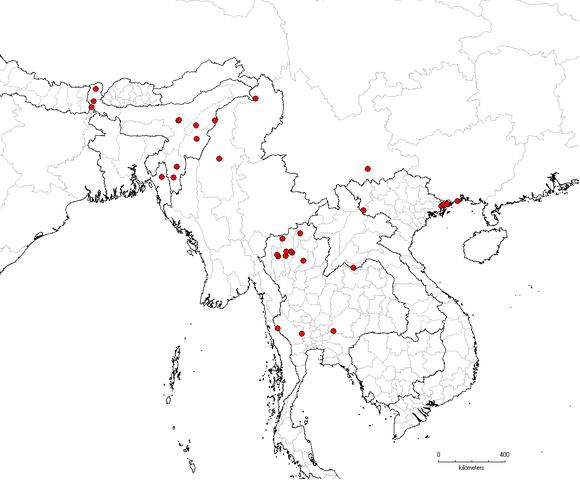Merremia kingii
Nomenclature
Accepted name/Authority/Place of publication:
Merremia kingii (Prain) Kerr, Fl. Siam. 3(2): 5. 1954.
Synonyms:
Ipomoea kingii Prain, J. Asiat. Soc. Bengal, Pt. 2, Nat. Hist. 63(2): 110. 1894.
Ipomoea cymosa var. macra C.B.Clarke in Hook., Fl. Brit. India 4: 212. 1885.
Description
Habit:
Perennial climber; stems terete.
Leaves:
Leaves ovate, 9–14 by 5–8.8 cm, glabrous or sparsely hairy along veins underneath, base cordate, apex attenuate-acuminate; petiole 2.5–10 cm, puberulous, base with 2 subulate pseudostipules, 2–3 mm long.
Inflorescences:
Inflorescence lax, a cymose panicle, usually 5–12-flowered; peduncles 5–15 cm long, glabrous; lower bracts foliose; pedicels clavate, 25–50 mm long, flanged and minutely verrucose apically, grooved between pedicel apex and sepal bases.
Flowers:
Flower sepals unequal, deeply concave, broadly elliptic to narrowly obovate, 16–21 mm long, medially coriaceous, margins thinner, apex rounded or obtuse, persistent and reflexed in fruit; corolla funnelform, 3.8–5.3(–6.3) cm long, white to pale yellowish, tube base cylindrical, flaring abruptly, limb c. 5 cm diam., 5-lobed, minutely hair-tufted on lobe tips, otherwise glabrous; stamens unequal, filaments sparsely pilose below insertion, anthers opening lengthwise, hair-tufted apically.
Fruits:
Capsules ovoid-conical, 10–12 mm long, dark brown, glabrous.
Seeds:
Seeds subglobose-trigonous, c. 6–7 mm long, brownish hairy.
References:
Staples, G. 2010. Convolvulaceae. Fl. Thailand 10(3): 330–468.
Biogeography, Ecology and Natural History
Distribution Map:

Distribution:
India, Bhutan, Myanmar, Thailand.
Ecology:
In clearings, open spaces along streams,
roadsides in evergreen and deciduous forests; altitude: 400–1400 m.
Phenology:
Flowering: January–March, November; fruiting: February, May, November.
References:
Staples, G. 2010. Convolvulaceae. Fl. Thailand 10(3): 330–468.
Other information
Common names and uses:
Common names and uses. Chingcho doi (Thai).
Authorship for webpage
Editor:
George Staples, Esmond Er
Contributors:


Prain, in the protologue, cited numerous specimens from Assam, Khasia Hills, Naga Hills, Shan Hills, Bhutan, and Sikkim; under the current Code of Nomenclature these would all be considered syntypes. Typification of this name is problematic and requires study of the original material in Calcutta, not presently available. Duplicates for some of the collections Prain cited are present in Kew (isosyntypes) and have been examined. Where corolla colour is mentioned on the labels these report only white flowers. Thai specimens agree with these isosyntypes but corolla colours from white to cream to pale yellowish and even yellow are reported. Probably M. kingii is variable in flower colour, like others in Merremia sect. Xanthips. Species delimitation between M. kingii, M. bambusetorum, and M. umbellata remains ambiguous.